In a recent media release, the German Wine Institute (Deutsches Weininstitut – DWI) reported a significant decrease in the percentage of wine-buying households in Germany for the third quarter of 2023 compared to the previous year.
This data, sourced from NielsenIQ’s household panel, which tracks the purchases of private households, reveals telling shifts in the wine market.
Decline in German Wine Consumption
The proportion of wine-buying households fell from 36.9% in 2022 to 33.8% in 2023, marking a decrease of about 3%. Specifically, the share of German wine dropped from 25.4% to 22.6%, and foreign wines from 26.5% to 23.6%. This downturn, which began in the second quarter of 2023, appears to be continuing unabated.
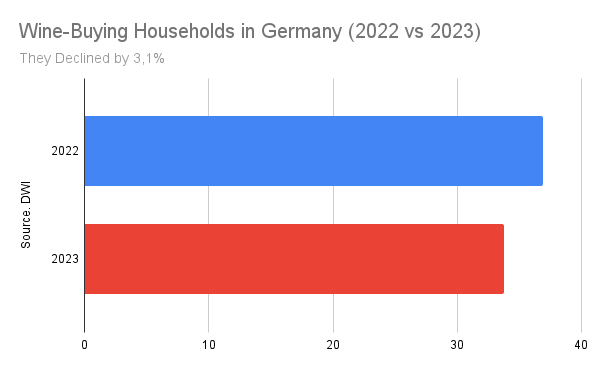
The rise in prices, particularly of German wines, has been a significant factor in this decline. Despite an increase in average prices by approximately 10%, German wines managed to maintain their market share in terms of revenue at 46.4%. Meanwhile, Italian wines gained 1.6% to reach an 18% market share, while France, Spain, and overseas origins saw slight decreases.
Italy Wins Again
In terms of types of wine, Germany saw an increase in the market share for white wine by 4.8%, while red wine experienced a steep decline of 10.8%. Italy emerged as a clear winner across all wine colors, particularly in white wine, with a 27.1% increase. Overseas saw large declines.
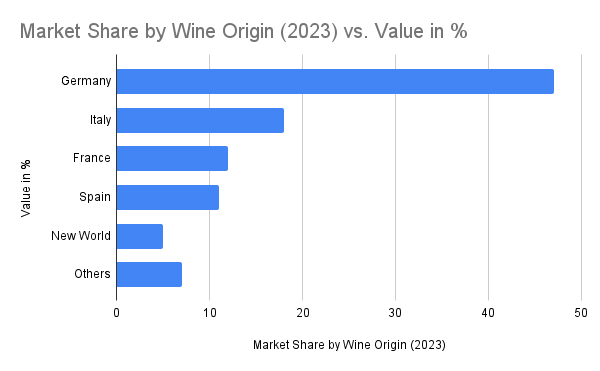
Export and Import Dynamics
Despite a challenging economic environment, the average export price for German wines in 2022 rose by €0,20, reaching a new high of €3.15 / liters. This led to a 4% increase in the value of German wine exports, totaling €370m, even though the volume decreased by 3% to 1.17m hl.
The USA, Norway, the Netherlands, the UK, and China were among the top export markets. Notably, exports to China increased by 24% in volume and 22% in value, with an average price of €512/hl
Suprisingly, German wine exports to Russia witnessed an unprecedented surge, marking a significant shift in the global wine market dynamics. The value of these exports soared by 87.3% to €12,931,000, while the volume increased by 89.4% to 56,745 hectoliters. This remarkable growth has elevated Russia to the 11th wine export market, now accounting for 3.5% of Germany’s total wine exports. The average price of €228 per hectoliter underlines the moderate quality of German wines that are increasingly favored in the Russian market.

Domestic Sales and Imports
On the domestic front, the average price for German wines rose to €4.18/L, but volumes sold decreased by over 14%, leading to an 8% drop in revenue. Foreign wines also saw a decrease in both volume and revenue, with an average price of €3.64/L. Italian, French, Spanish, American, and Austrian wines topped the import lists, with significant value increases despite volume losses.
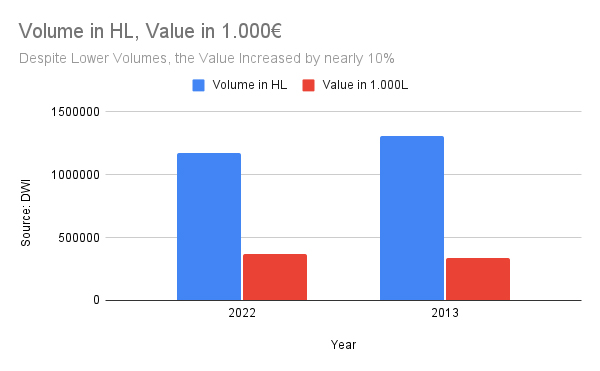
Off-Trade Remains Significant
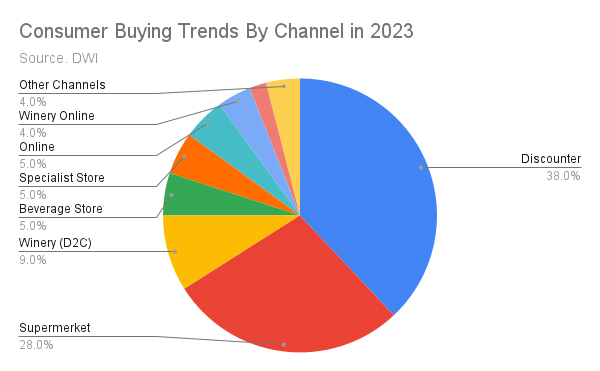
The per capita consumption of wine in Germany declined by 4% to 19.9 liters in 2022, while sparkling wine consumption remained steady at 3.2 liters. The majority of wine purchases (64%) were made through retail, with discount stores accounting for 37% of these sales.
These figures paint a complex picture of the German wine market in 2023. The shift in consumer behavior, influenced by economic factors and price changes, has led to noticeable changes in market shares and consumption patterns. The resilience of certain segments, like German wine in terms of revenue and Italian wine in market share, highlights the dynamic nature of the wine industry.
The report can be found on German here.
Thanks for Reading!
Glad you dropped by! If the insights here struck a chord, why not share them? And if you’re eager to talk more, I’m all ears – just reach out. Looking for someone to spark inspiration in your masterclass or brand event? Let’s talk and set up something amazing.
Disclaimer
This text was neither commissioned nor compensated. It reflects exclusively my own opinion.

ConVINOsation Podcast Brings EUROVINO Wine Fair to Life
In collaboration with Messe Karlsruhe, we are proud to launch ConVINOsation, a new podcast dedicated to tackling the wine industry’s most pressing topics. Hosted by

Live on Wein Verkauft!
I recently had the opportunity to join freelance consultant Diego Weber from Germany on his podcast, On German!. Over the course of the two-hour episode,

Live on the Morning Show
In July 2024, I had the exciting opportunity to appear on New York’s WTBQ Frank Truatt’s Morning Show, the #1 drive time morning show, with
Challenging Year for French Wines & Spirits Exports 2023
In the year 2023, the French wine and spirits sector navigated through challenging waters to post exports worth €16.2 billion. Despite representing a 5.9% decline from the previous year, this figure stands as the second-highest in the industry’s export history. The volume of exports also saw a considerable reduction, falling by 10.4%. However, the sector managed to maintain its status as the leading contributor to France’s agri-food surplus and the third largest in the nation’s overall trade balance, with a trade surplus of €14.8 billion, down by 5.8%.

DWI Announces Winner of the Sommelier Cup 2024
The DWI Sommelier-Cup 2024, hosted by the German Wine Institute (DWI), concluded on January 22, 2024, with Katharina Iglesias from wineBank in Hamburg claiming the title. The event, held at the Atrium Hotel in Mainz, witnessed participation from 28 professionals across various sectors of the wine industry. While the competition’s popularity remains undeniable, a critical examination of its structure and outcomes reveals aspects worth contemplating.
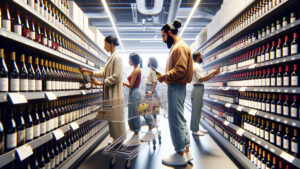
German Wine Consumption Plummets in 2023
The German wine consumption and buying behaviour is changing. (Photo: DallE)

